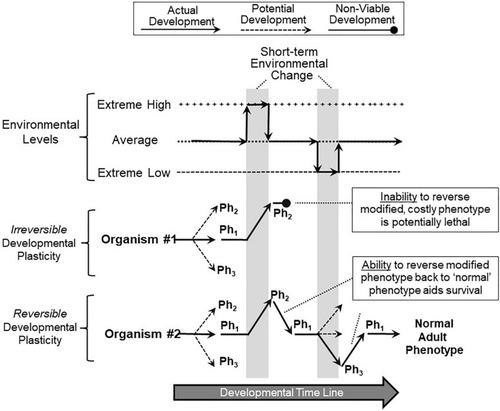FIGURE 4
- ID
- ZDB-FIG-200212-29
- Publication
- Burggren, 2020 - Phenotypic Switching Resulting From Developmental Plasticity: Fixed or Reversible?
- Other Figures
- All Figure Page
- Back to All Figure Page
|
Implications of reversible and non-reversible developmental phenotypic plasticity. In this scenario, two organisms are tracked during their development as they experience multiple, short-term extreme environmental changes (vertical gray bars). Both Organism #1 (red) and Organism #2 (blue) respond to the first extreme environmental change by switching from their normal range of phenotypes (Ph1) to a specialized, adaptive phenotype (Ph2) that allows continued survival in that environment. However, Organism #1, lacking the ability to reverse (correct) its phenotype that was suitable for the extreme high environment, is now non-viable when the environment reverts back to more typical conditions as development continues. Organism #2, which similarly responded to the first environmental change with a switched phenotype (Ph2), has the ability to reverse or correct the costly or even lethal modified phenotype back to normal ranges (Ph1) when the environment returns to normal, aiding its survival. Organism #2 can also move to other phenotypes (Ph3) and revert back to normal ranges (Ph1) as subsequent environmental swings occur. Thus, in this overall scenario, reversible phenotypic switching during development heavily favors survival of the developing organism. |

